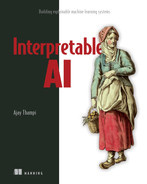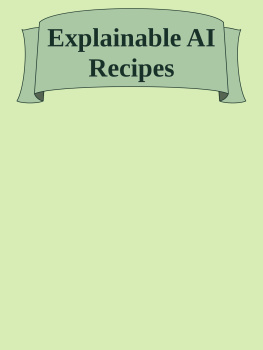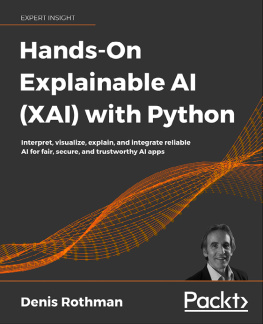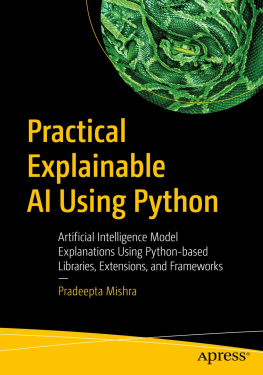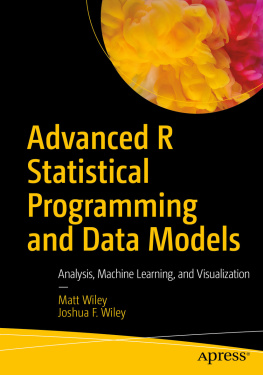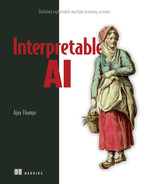Ajay Thampi - Interpretable AI: Building explainable machine learning systems
Here you can read online Ajay Thampi - Interpretable AI: Building explainable machine learning systems full text of the book (entire story) in english for free. Download pdf and epub, get meaning, cover and reviews about this ebook. year: 2022, publisher: Manning, genre: Children. Description of the work, (preface) as well as reviews are available. Best literature library LitArk.com created for fans of good reading and offers a wide selection of genres:
Romance novel
Science fiction
Adventure
Detective
Science
History
Home and family
Prose
Art
Politics
Computer
Non-fiction
Religion
Business
Children
Humor
Choose a favorite category and find really read worthwhile books. Enjoy immersion in the world of imagination, feel the emotions of the characters or learn something new for yourself, make an fascinating discovery.
- Book:Interpretable AI: Building explainable machine learning systems
- Author:
- Publisher:Manning
- Genre:
- Year:2022
- Rating:4 / 5
- Favourites:Add to favourites
- Your mark:
Interpretable AI: Building explainable machine learning systems: summary, description and annotation
We offer to read an annotation, description, summary or preface (depends on what the author of the book "Interpretable AI: Building explainable machine learning systems" wrote himself). If you haven't found the necessary information about the book — write in the comments, we will try to find it.
In Interpretable AI, you will learn:
Why AI models are hard to interpret
Interpreting white box models such as linear regression, decision trees, and generalized additive models
Partial dependence plots, LIME, SHAP and Anchors, and other techniques such as saliency mapping, network dissection, and representational learning
What fairness is and how to mitigate bias in AI systems
Implement robust AI systems that are GDPR-compliant
Interpretable AI opens up the black box of your AI models. It teaches cutting-edge techniques and best practices that can make even complex AI systems interpretable. Each method is easy to implement with just Python and open source libraries. Youll learn to identify when you can utilize models that are inherently transparent, and how to mitigate opacity when your problem demands the power of a hard-to-interpret deep learning model.
Purchase of the print book includes a free eBook in PDF, Kindle, and ePub formats from Manning Publications.
About the technology
Its often difficult to explain how deep learning models work, even for the data scientists who create them. Improving transparency and interpretability in machine learning models minimizes errors, reduces unintended bias, and increases trust in the outcomes. This unique book contains techniques for looking inside black box models, designing accountable algorithms, and understanding the factors that cause skewed results.
About the book
Interpretable AI teaches you to identify the patterns your model has learned and why it produces its results. As you read, youll pick up algorithm-specific approaches, like interpreting regression and generalized additive models, along with tips to improve performance during training. Youll also explore methods for interpreting complex deep learning models where some processes are not easily observable. AI transparency is a fast-moving field, and this book simplifies cutting-edge research into practical methods you can implement with Python.
Whats inside
Techniques for interpreting AI models
Counteract errors from bias, data leakage, and concept drift
Measuring fairness and mitigating bias
Building GDPR-compliant AI systems
About the reader
For data scientists and engineers familiar with Python and machine learning.
About the author
Ajay Thampi is a machine learning engineer focused on responsible AI and fairness.
Table of Contents
PART 1 INTERPRETABILITY BASICS
1 Introduction
2 White-box models
PART 2 INTERPRETING MODEL PROCESSING
3 Model-agnostic methods: Global interpretability
4 Model-agnostic methods: Local interpretability
5 Saliency mapping
PART 3 INTERPRETING MODEL REPRESENTATIONS
6 Understanding layers and units
7 Understanding semantic similarity
PART 4 FAIRNESS AND BIAS
8 Fairness and mitigating bias
9 Path to explainable AI
Ajay Thampi: author's other books
Who wrote Interpretable AI: Building explainable machine learning systems? Find out the surname, the name of the author of the book and a list of all author's works by series.

